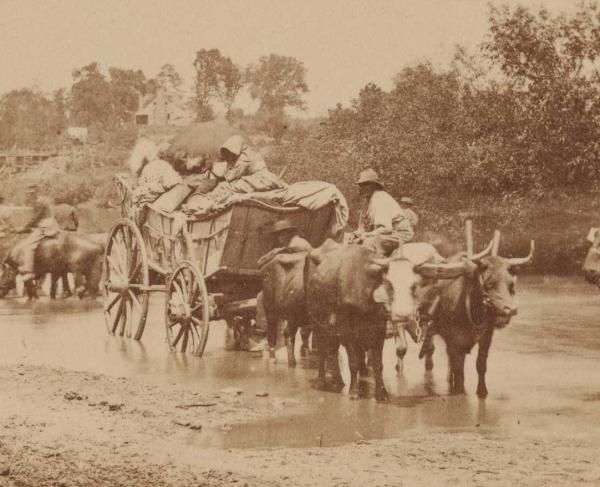
Since its creation in 1861, the 21st Infantry Regiment – the “Gimlet” regiment – has earned 56 wartime campaign streamers – a record matched by few Army units. But its distinctive insignia and coat of arms harken back to its earliest history, featuring a green cedar tree to commemorate its first trial by fire at Cedar Mountain in 1862, and a cluster of four arrows bound by a rattlesnake, a symbol for the regiment’s eight Indian Wars campaigns in the American West in the late 19th century.
The 21st Infantry Regiment was originally constituted in May 1861, as the 2nd Battalion, 12th Infantry Regiment and organized in May 1862 at Fort Hamilton, N.Y. The new, young soldiers of this new unit were dispatched to Harper’s Ferry before facing combat for the first time in the battle at Cedar Mountain on Aug. 9, 1862.
Serving as lead skirmishers for a Union division, the regiment’s soldiers fought admirably and helped the advancing Union lines initially break through the Confederate defenses, only to be outnumbered and compelled to withdraw. At Cedar Mountain, the American Battlefield Trust has saved 498 acres of the land where the regiment’s soldiers first fought.
The regiment’s fighting spirit was exemplified by Private John L. Younker, who volunteered to brave a storm of grape shot and canister to deliver a desperate message to Union artillerists to stop shelling their own men. Younker was wounded in the arm during his mission and was awarded a Congressional Medal of Honor.
The regiment went on to fight at Second Bull Run, Antietam, Mine Run, the Wilderness, Spotsylvania Court House, North Anna and Cold Harbor. In 1866, as part of an expansion of Regular Army, the 2nd Battalion, 12th Infantry Regiment, which had served in 12 campaigns during the Civil War, was reorganized and re-designated what it is today – the 21st Infantry Regiment.
The regiment was sent to Arizona during the Indian Wars, battling with Apaches in frequent engagements from 1869 to 1872 during scouting expeditions and while defending settlers and mail carriers against Indian attacks and raids. In 1873, the 21st fought in the Modoc War in northern California, and four years later pursued Chief Joseph and the Nez Perce tribe through the Wyoming and Montana until their surrender in October. In that campaign, the soldiers of the 21st marched more than 1,600 miles in 75 days from July to October over some of the most difficult, desolate terrain in the West.
In the Spanish-American War, the 21st participated in the assault on San Juan Heights in Santiago, Cuba, in 1898. The following year, the regiment was ordered to the Philippines to help put down an insurrection. There, in addition to fighting, they began to use counterinsurgency and pacification strategies, offering amnesty to insurgents while launching improvement projects, such as building roads and schools and improving sanitation and security. The regiment would use some of these same strategies more than a century later while serving in Iraq.
The regimental nickname, “Gimlet,” originated in the 1920s from peacetime athletic exploits. A gimlet is a rock-boring tool, and after the regiment was stationed in Honolulu in 1921, the 21st so thoroughly bored through the competition in inter-regimental baseball, football and sports leagues, it gained the nickname. “Gimlet” is officially authorized by the Army, through its Center of Military History, as the regiment’s “special designation.”

Twenty peaceful years in Hawaii came to a sudden, violent end when the Japanese attacked Pearl Harbor. Soldiers of the 21st were among the first U.S. fighters to engage in combat with the Japanese, defending Wheeler Army Air Field with small arms, including bolt-action rifles.
The regiment served in the Pacific throughout World War II, fighting at New Guinea and on Leyte island, where it suffered heavy casualties during the liberation of the Philippines in 1944. On November 5, 1944, the 21st Infantry arrived at “Breakneck Ridge” on the north coast of Leyte.
Facing fierce Japanese resistance, on Nov. 8 the Gimlets assaulted the ridge in the face of the driving rain and wind of a South Pacific typhoon. The storm, as well as brutal fighting, slowed the regiment’s progress. But on Nov. 12, after bitter fighting and heavy casualties, the men of the 21st Infantry secured “Breakneck Ridge” and ended significant enemy resistance on Leyte.
The regiment also saw heavy fighting, often at close quarters, during the liberation of Mindanao, the second largest of the Philippine islands, from April 17 to June 19, 1945. The campaign – 63 days of continuous fighting – was the regiment’s longest and last campaign of the war.

The 21st Infantry was the first Army unit to deploy in Korea in July 1950 and saw some of the Korean War’s toughest combat, fighting vicious battles against vastly superior North Korean forces throughout July and into August until more Army units could be brought in.
The 24th Division, which included the 21st Infantry, was awarded a Presidential Unit Citation for its courageous service in Korea against a far-larger enemy force from July 2 to Sept. 15, 1950. The regiment also fought in all three major campaigns in Korea in 1951.
During 1951, three 21st Infantry companies were awarded Presidential Unit Citations, which are issued to military units that exhibit extraordinary heroism during combat. On May 27, 1951, the Regimental Headquarters Company and Medical Company repeatedly repulsed enemy attempts to overrun their command post and aid station, earning unit citations. And Company G was awarded a unit citation seizing and holding two hills against fanatical enemy attacks in October 1951. That year, two Gimlets were posthumously awarded the Medal of Honor for heroic actions above and beyond the call of duty.
The 21st Infantry’s 3rd Battalion was in Vietnam for six years – 1966-72 – and fought in 14 of that war’s 17 campaigns. It participated in Operations Attleboro, Cedar Falls and Junction City, among others, and also fought around Chu Lai in the northern part of South Vietnam.
When six wounded soldiers of the 21st were caught in the open during combat in the Quang Tri province on May 14, 1969, Pfc. Daniel Shea rescued them before being mortally wounded, earning him a posthumous Medal of Honor. When the 3rd Battalion departed Danang on Aug. 23, 1972, it was the last U.S. Army ground combat battalion to leave Vietnam.
The 21st Infantry’s 4th Battalion served in eight campaigns in Vietnam from 1968 to 1971, primarily around Duc Pho, a key rice-growing area that was fiercely fought over. On August 26, 1968, Staff Sgt. Nick Bacon earned the Medal of Honor for taking command after two platoon leaders fell and, at great personal risk and exposure, led successful counterattacks that won the day.
The sacrifices of the young soldiers of the 21st Infantry Regiment have continued during the War on Terrorism. The 1st Battalion, 21st Infantry, served a 13-month tour of duty in and around the city of Kirkuk, Iraq, in January. 2004, aggressively fighting insurgents while leading civil initiatives to weaken the influence of the radical enemy forces. The 1st Battalion returned in 2007 for a 15-month tour at Camp Taji northwest of Baghdad. In 2004-05, the 3rd Battalion served in and around Mosul, and returned for a second tour in September 2008 in Diyala Province northeast of Baghdad.
Related Battles
2,353
1,338
14,462
7,387
12,401
10,316
17,000
13,000


